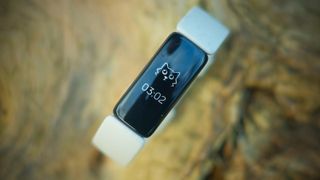Elevated ranges of ‘eternally chemical substances’ current in smartwatch bands – here’s what it is good to know
- Scientists have examined the extent of PFAS in some consumer smartwatch bands
- They found elevated ranges of “eternally chemical substances” in some fashions
- These chemical substances are doubtlessly toxic and have been linked to illnesses much like most cancers
Scientists from the School of Notre Dame have known as for further full analysis and better transparency from producers after a look at found elevated ranges of so-called “eternally chemical substances” in some consumer smartwatch and well being tracker bands.
The look at, revealed this week in Environmental Science & Experience Letters, analyzed 22 watch bands from fairly just a few producers and value components and situated that just a few of those bands contained elevated ranges of PFAS (polyfluoroalkyl substances), particularly perfluorohexanoic acid (PFHxA). These chemical substances are colloquially commonly known as “eternally chemical substances” on account of they’ve an almost unbreakable chemical development which suggests they don’t degrade or break down over time.
The examined producers embody a lot of the best smartwatch producers and accent makers along with Apple (and Apple Watch Nike sport bands), CASETiFY, Fitbit, Google, and Samsung.
As reported by Notre Dame Info, 9 of the 22 bands examined contained elevated ranges of PFHxA, with dearer bands sometimes found to have elevated ranges.
“In all probability essentially the most distinctive issue we found on this look at was the very extreme concentrations of just one PFAS — there have been some samples above 1,000 parts per billion of PFHxA, which is method elevated than most PFAS we have now now seen in consumer merchandise,” talked about Graham Peaslee, look at co-author and professor emeritus throughout the Division of Physics and Astronomy.
PFAs in smartwatch bands, should you be apprehensive?

“This discovery stands out as a result of very extreme concentrations of 1 form of eternally chemical current in devices which might be in prolonged contact with our pores and pores and skin,” Peaslee suggested Unbiased. “We have under no circumstances seen extractable concentrations throughout the part-per-million range for any wearable consumer product utilized to the pores and pores and skin,” he warned. The look at’s lead author, Alyssa Wicks, recommends searching for lower-cost silicone bands, or avoiding merchandise listed as containing fluoroelastomers in the event that they want a dearer band.
Whereas the look at does level out some large names throughout the smartwatch sector, notably Apple, Samsung, and Google, it’s troublesome to extrapolate an extreme quantity of on account of the look at wouldn’t give the outcomes for each mannequin. Companies like Apple clearly promote Fluoroelastomer as present in its best Apple Watch bands, notably its Nike decisions, Sport Band, and the Apple Watch Extraordinarily’s Ocean band. Nonetheless, the look at wouldn’t inform us which of the bands offered by these fundamental avid gamers had been examined, or within the occasion that they’d been the bands with notably extreme PFA ranges.
Samsung and CASETiFY weren’t immediately obtainable to the touch upon the story. Apple pointed TechRadar to its work on testing provides and its dedication to utterly phasing out PFAS from its merchandise and manufacturing processes from 2022.
Further significantly, Apple moreover highlighted its Regulated Substances Specification doc, which significantly lists PFHxA, the offending chemical highlighted throughout the look at, as a restricted substance. Apple says that for PFHxA, its salts and related substances, it has a threshold limit of “25 ppb for the sum of PFHxA and its salts” and “1000 ppb for the sum of PFHxA-related substances.”
“Don’t panic”
As Wicks notes, there are moreover “few analysis” on the absorption of PFAS by the pores and pores and skin. She cites one such article that found that just a few forms of PFAS had “very important swap by the pores and pores and skin”, nevertheless that it was a restricted look at that solely examined 20 of the 14,000 acknowledged forms of PFAS.
Chatting with Yahoo Life, Jamie Alan, affiliate professor of pharmacology and toxicology at Michigan State School known as the findings “attention-grabbing”, nevertheless talked about that the look at wouldn’t give any notion into how quite a bit PFHxA is absorbed by the pores and pores and skin, if any is absorbed the least bit. Completely different specialists in toxicology and dermatology agreed, stating that it is unlikely a significant amount of PXHxA may very well be absorbed by the pores and pores and skin. Lastly, Alan recognized that the look at involved chemically extracting these compounds from Apple Watch bands, one factor prospects aren’t doing as soon as they placed on these items day-to-day. “So although they found very extreme ranges, that does not indicate any very important amount is transferring into our system,” she concluded.
Alan talked about there is no such thing as a should panic should you occur to non-public a smartwatch or well being tracker band with fluoroelastomer, nevertheless that “it is good to focus on cumulative publicity.” For individuals who’re looking out for a model new band, it’s possible you’ll on a regular basis choose a PFAS-free selection.






